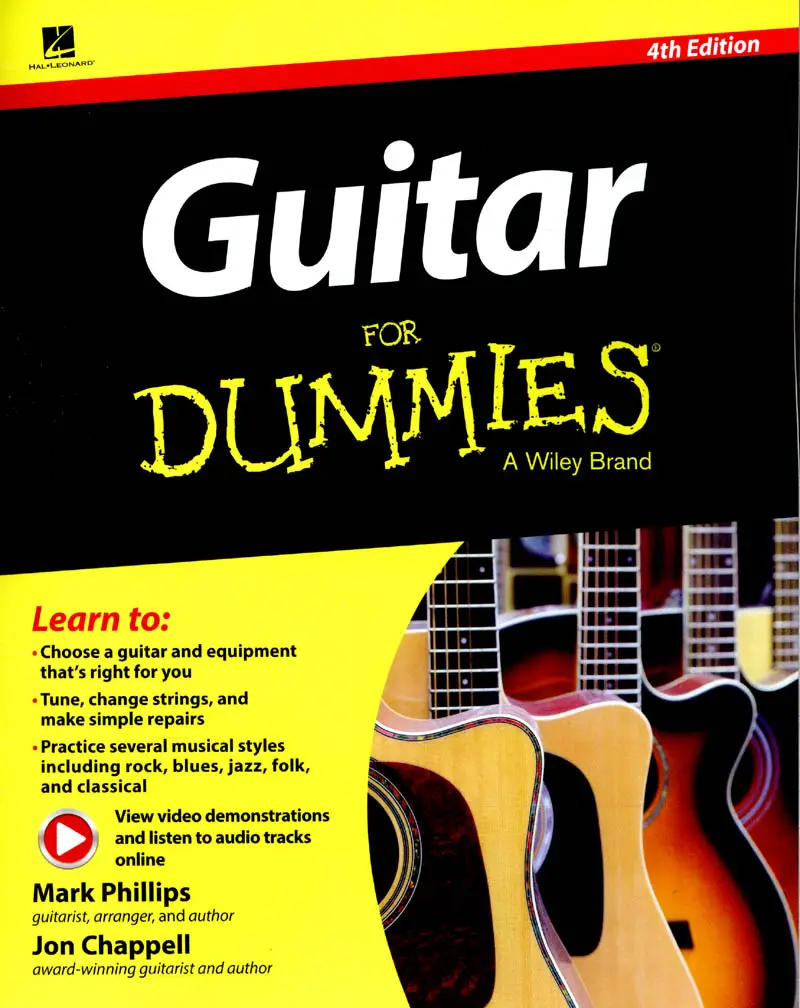Is Guitar for Dummies A Good Book? (An Inside Look)
Everyone has heard of the ‘Dummies’ series of books, and they are great introductory guides to many different subjects.
Guitar for Dummies is a comprehensive book designed to build your musical vocabulary by teaching you chords, riffs, and songs, and includes 85 videos and 95 audio tracks to learn from and play along with. Readers mostly praise this book saying it’s a great way to start learning guitar.
Don’t look at this book as being purely for beginners though, as there is plenty of material to take you well into an intermediate player level.
When you look at the low cost of this book, and the experience behind the writers who constructed the content, we think it is great value and it can also be a great reference to use alongside lessons with a teacher.
If you’re looking to start your guitar journey, then we recommend this book as being one of the better options available.
So, why is Guitar For Dummies a good book for beginners?
Let’s take a closer look at the chapters and subjects inside the book, and the good vs bad points so that you can ultimately decide for yourself if this book will be right for you.

Who is Guitar For Dummies Aimed At?
The book is primarily aimed at new guitar learners and is designed to get you going from the very start. Guitar For Dummies has been through a few versions now, and is currently in the 4th edition which was published in 2016 and has 400 pages inside.
Although Guitar for Dummies is aimed at all ages, we feel it’s generally not suitable for children under 10-12 years of age as the material can be too difficult for them to read.
Some reviewers of this book believe you would be best having a small amount of guitar or music experience before reading it and have found it a great resource for ongoing learning.
That being said, there are plenty of absolute beginners who have found this book a good experience to get started with, and are happy with the step-by-step approach the book takes.
As we mentioned earlier, this book will take you beyond the basics and is also a handy resource for intermediate guitarists.
- It covers theory and lessons in different styles of music like 12 bar blues, minor pentatonic scales, rhythm, folk, jazz, and classical.
Whether you find this book easy or hard may depend a little on your ability to understand music concepts, and maybe also if you have someone who can help when you are stuck on a particular section.
If you’re just thinking about starting guitar – take a look at our article about whether guitar is easy or hard to learn at home by yourself.
Was The Book Written By Professional Musicians?
Guitar for Dummies was written by Jon Chappell and Mark Phillips.
- ‘Great’ …you say, but who are they?
Mark Phillips is an author, guitarist, arranger, editor, and publisher with more than 40 years in the music publishing field and holds a master’s degree in music theory from Northwestern University,
Author Jon Chappell is a multistyle guitarist, arranger, and author. He grew up in Chicago, and attended Carnegie-Mellon University. He also holds a master’s degree in composition from DePaul University
For a closer look at Jon Chappell’s teaching here’s a video of ‘Learning Guitar For Dummies’.
Is Guitar for Dummies Easy to Follow?
People who review this book say that it is an easy to follow and fun to read book that helps you to get the basics down quickly and is suitable for people of all ages.
With the lesson plan in this book, you don’t feel rushed to get through the material, and you can learn at your own pace.
Many reviewers say that if they had this book when first learning guitar it would have helped them learn much faster.
Not all people found this book so easy to follow, so check the section below for things readers did not like about this book.
What Chapters Are in the Book?
These are the chapters included in the book, let’s take a brief look at them:
Chapter 1: Guitar Basics: The Parts of a Guitar and How it Makes Music
- Looks at the basic terminology of guitar parts on both acoustic and electric guitars (with photos).
- They also discuss how guitars make sound by vibration of the strings.
Chapter 2: How to Tune Your Guitar
- Tuning guitar – kinda says it all! But if you’re new to tuning a guitar then this chapter is vital to give you some methods of tuning your guitar correctly.
- To Do this it discusses what frets are and where to hold the strings when tuning. They also discuss using external sources to tune to.
Chapter 3: Preparing to Play: Holding the Guitar and Reading Guitar Notation
- You’ve no doubt seen people playing guitar, but when you first try it can be awkward until you know how to hold it properly, and this chapter takes you through ways to hold a guitar.
- It also introduces you to TAB – generally recognised as an excellent way for guitarists to read music specifically for guitar.
Chapter 4: The Best Way to Begin: Strumming Chords
- This chapter discusses 4/4 timing and introduces the concept of strumming with rhythmic timing in downward strokes.
- They then introduce up strokes in-between the down strokes to add syncopation.
Chapter 5: Playing Melodies — without Reading Music!
- In chapter 5 the lessons move on to playing single strings melodies, and how to correctly pick strings.
- They also introduce the alternate picking method into your playing.
Chapter 6: Adding Some Spice with 7th Chords
- Now the lessons move beyond basic major and minor chords, and branch out to dominant 7th chords, which give you more playing variety and are used regularly in blues music.
Chapter 7: Making Things Smooth by Playing in Position
- Now they move on to discuss playing melodies further up the neck, to free you from playing everything in the first few frets.
- They also introduce the concept of transposing, and how to play the same melody in different places on the neck.
Chapter 8: Doubling Up with Double-Stops
- Double-stops involve playing two strings ate once for a fuller sound, and this chaper discusses how to play scales and progressions using double-stop all over the neck.
Chapter 9: Stretching Out: Barre Chords
- Once you learn how to construct barre chords this frees you from only playing chords in the open position, and opens up your ability to play chords anywhere on the neck.
Chapter 10: Special Articulation: Making the Guitar Talk
- Once you reach this level the lessons start showing you how to get more expression from your guitar through the use of bends, hammer-ons, and pull-offs.
Chapter 11: Ready to Rock: Rock Guitar Basics
- Now the book dives into constructing basic rock lick by using the techniques learn in the last chapter, and they also introduce slash chords to add some more flavour.
- Finally, they get you practicing walking bass lines.
Chapter 12: Bluer Than Blue: Blues Guitar Basics
- Time to play the blues. In this chapter 12 bar blues are introduced, and you learn to play with a triplet feel, and use the techniques you learnt in previous chapters to do double-stop lead runs leading down into bass blues lines.
Chapter 13: Around the Campfire: Folk Guitar Basics
- In chapter 13 the lessons teach you about fingerpicking arpeggios, and specific fingerpicking techniques like thumb-brushing and travis-picking.
Chapter 14: Maestro, If You Please: Classical Guitar Basics
- At this point in the book the lessons depart from the mainstream learning and start teaching the basics of classical style playing.
- You will only do this chapter if classical style is of interest to you.
Chapter 15: Sunglasses and Berets: Jazz Guitar Basics
Jazz guitar involves more complex chords and modified notes in the scale. Like classical you may choose to skip this chapter, however it’s worth a look as jazz guitar can give you many ideas to add to your playing style.
Each lesson in the book will first take you through some theory, and then put this into practice with practical technique exercises.
Finally, you play along with music videos that incorporates what you have just learnt.
So as you can see, the book starts with the absolute basics, and moves you forward one step at a time on your guitar learning journey.
Can You Skip Chapters to More Advanced Lessons?
Some guitarists may just want specific sections, or maybe are not interested in a particular style in a section, like classical guitar for example.
The book gives you pointers to jump ahead to certain sections, so you can sometimes skip a part, or jump forward to grab a new technique before returning to the chapter you were first learning.
Sometimes this can make things a bit more interesting and fun, giving you a little glimpse of more interesting playing and techniques to come.
Are There Bad Things about The Guitar for Dummies Book?
Like all music learning books, there is always something that people don’t like, even if they like the book overall.
With this book some people say they wish there were more enjoyable songs than “Kumbya”, “Swing Low, Sweet Chariot” and “Old McDonald” in the beginning chapters, as some of them are quite dated and cheesy sounding songs.
Fortunately, not all songs are so basic, and the book does progress onto more interesting songs the further you go.
Guitar for Dummies is aimed at all ages, but some readers find the puns and jokes in the text are a bit overbearing – and yes, we know it’s hard for a joke to be funny for a 15 year-old and 60 year-old at the same time!
For instance:
On playing with calluses: “Like a Supreme Court Justice, you have calluses for LIFE!”, yes maybe funny for some, but probably not for many. Possibly the authors should have left their comedy lines out of the book!
Other readers state that the photos of hand positions when playing chords are not clear enough for them, and they are not sure where to place their thumb behind the neck.
Another complaint from some is that they find it hard to play along with the song audio tracks, as the chord changes are too fast for them.
They also mention that the book doesn’t really explain how to get faster at chord changes.
A noted shortcoming in Guitar for Dummies is their discussion and demonstration of strumming.
They simply strum across all the strings, missing the point that you can strum different groups of strings for more character and variation when strumming.
Finally, some guitar learners found it frustrating in the book when the chapter says to practice the newly learnt chords, but gives no indication of how long to practice, or when you should move on to the next section.
Conclusion – The Final Wrap Up
Guitar for Dummies makes learning guitar easier on your own than following random videos online.
The lesson plans are broken down into steps that are not complicated to follow, and most learners get good value from the progressive style of the book.
Some people may find the teaching style in this book and on the video lessons a bit ‘mechanical’ without much variety and interest, so watch the free content the provide online first to help you decide if this course is for you.
You will find plenty of interesting courses online both free and paid, and we think many of these are a great way to learn guitar, however the benefit of having a guided lesson book can be of great benefit also.
- If you choose this book, then you will definitely improve at guitar and learn new skills to propel you into further learning.
However, if the lesson plans look a bit dull to you then have a look online – there are some great courses available, just make sure to pick a course that builds your skills gradually in the same manner as this book.
We hope that you now have all the information you wanted about this book, are can now choose what your next step is with learning guitar.
If you want to see some of the video lessons for free that go with the book, then click this link to go to the dummies.com website.



